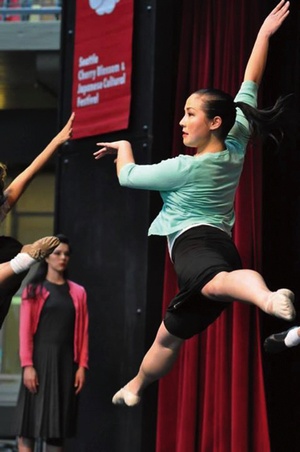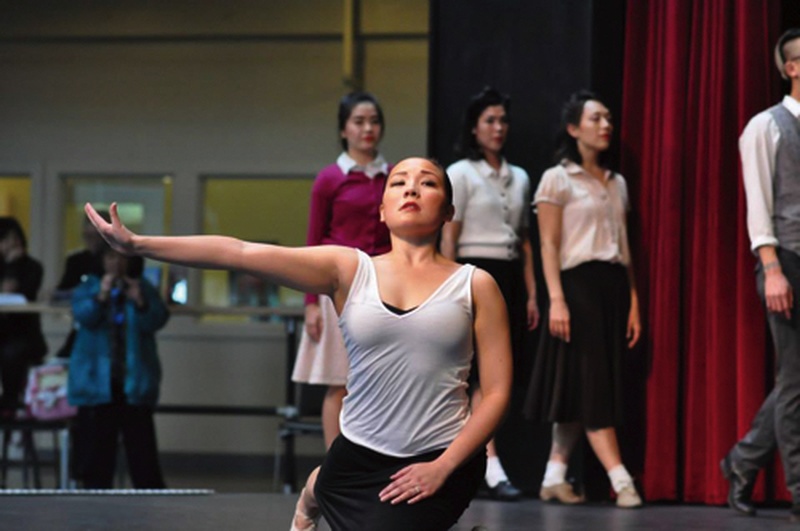Gabriella Gaynor is a Japanese-American active in the Seattle area. She works in public relations at the Seattle Opera, and also founded her own dance company, where she works as a choreographer and dancer. We followed up on her thoughts about her status as a fifth-generation Japanese-American and how it relates to her own activities.
"My great-great-grandfather came to the United States after the San Francisco earthquake in 1906 and worked as a carpenter to help rebuild the city. Then World War II came and my great-grandparents were sent to an internment camp at Heart Mountain, where my grandfather was born."
Although she is a fifth-generation Japanese, Gaynor knows a lot about her family history. Many of her relatives are in California, and even after her parents moved to Seattle, she maintained strong ties with her Japanese-American relatives. Although she is of Filipino and Irish descent, she says this is one of the reasons she identifies as "Japanese."
"I've always been conscious of being Japanese. Maybe it's because I grew up in a house where Japanese words were flying around. My mother had me at a young age, so my grandfather, who was a third-generation Japanese, took care of me a lot."
Her grandfather, whose mother was a second-generation American (a second-generation American born in the United States but raised in Japan for an education), was knowledgeable about Japanese culture and strongly influenced her. Her great-grandmother gave her the middle name "Kazuko."
He says he learned a lot from his grandfather. Not only did he learn about Japanese culture and the history of Japanese-American internment during World War II, but he also talked about the importance of human rights issues and social justice, including his experience helping Mexican immigrant farm laborers. He says it's because of his grandfather's teachings that he's now involved in the Seattle chapter of the Japanese American Citizens League (JACL).

(Photo by Gabriella Kazuko Gaynor)
While the Yonsei and Gosei generations are interested in social justice and are engaged in various activities, Gaynor expresses herself through dance. She founded the dance company "Reley Dance Collective" and continues to work with local dancers and choreographers.
In 2014, she created a piece about the internment of Japanese Americans during World War II, and performed it with ballet and taiko drumming at the JACL Seattle Chapter Dinner, the Wing Luke Museum, the Seattle Cherry Blossom Festival and Japanese Cultural Festival, and the Asian Pacific Heritage Month Cultural Festival. "It was a great opportunity to be able to connect my upbringing with dance in this way," Gaynor recalls.
The themes she deals with with her dance company are not limited to issues facing Japanese Americans, but also multiracial issues, and she is currently choreographing a piece that tackles stereotypes about Asian Hollywood stars.
"As a choreographer, I want to convey the impact stereotypes have on Asian people and how we have changed. As an Asian woman myself, I have experienced it, it makes me think about it every day, and because I have experienced it, I know how to convey it, so I want to tell that story."
He believes that creative work is one of the best ways to raise the issue of minority groups, because art can not only communicate with people but also have an impact.
Many young people, such as Japanese-American Troy Osaki, who performs poetry readings as introduced in this series, use these artistic activities to raise awareness of social issues. "I think it's wonderful that he is creating an opportunity for people to pay attention to social issues," says Gaynor. "Many of us Japanese-Americans don't have role models, so I think it's important for children to have role models who are active in some way. I hope that this will help inspire the next generation."
In Japanese communities with many generations, it may soon become unnecessary to refer to generations such as fourth and fifth generation. This is especially true for Japanese people with a relatively high rate of marriage with people of other ethnicities. There is a saying that "children grow up by watching their parents' backs," and the future of the Japanese community in this area in 20 or 30 years' time rests on the backs of the younger generation, like her.
*This article is reprinted from the January 25, 2016 edition of the North American Newspaper .
© 2016 Fumika Iawasaki; The North American Poset







